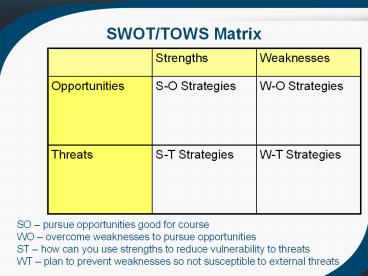SWOT/TOWS Matrix - PowerPoint PPT Presentation
1 / 6
Title:
SWOT/TOWS Matrix
Description:
SWOT/TOWS Matrix Strengths Weaknesses Opportunities S-O Strategies W-O Strategies Threats S-T Strategies W-T Strategies SO pursue opportunities good for course – PowerPoint PPT presentation
Number of Views:5072
Avg rating:3.0/5.0
Title: SWOT/TOWS Matrix
1
SWOT/TOWS Matrix
SO pursue opportunities good for course WO
overcome weaknesses to pursue opportunities ST
how can you use strengths to reduce vulnerability
to threats WT plan to prevent weaknesses so not
susceptible to external threats
2
StrengthWeaknessOpportunityThreatScenarioMark
eting a Course
- You have noted a decline of about 10 percent
annually over the past three years in your
enrolments. In addition the quality of the
applicants (reduced grade point average/TER and
background experience) has declined. - You have been asked by your Head of School to
work with University marketing to start preparing
a new plan to market the course more aggressively
to try and increase your enrolments as well as
retain your students. A change in strategy is
needed. - There is one other University in the State that
offers a similar program as well as 5 other
programs across Australia. - Five of you have come together to start
conceptualising a marketing plan. They are
yourself (CC), University Marketing
representative, Student Services Administrative
Officer, member of academic staff who teaches in
the course, and a final year student. - Use the SWOT analysis tool to analyse the status
of your School and how this information can then
be used to address the issues related to the
marketing of your course. - (Nominate a course to use as your example for
example, Engineering.)
3
Force Field Analysis
Driving Forces should be greater than Resisting
Forces
4
Force Field Analysis ScenarioIndigenisation of
the Curriculum
- The university has endorsed its Reconciliation
Action Plan and one of the elements in it is the
Indigenisation of the curriculum. Within your
faculty it has been interpreted as the inclusion
of one first year unit, followed by vertical
integration and the use of examples which
specifically relate to Indigenous peoples. Staff
are opposed to including a unit at year one
level, but support the concept of including some
information and examples in some units. - You would like to work with the academic faculty
staff to try and change their approach and
response to the Facultys interpretation of the
Indigenisation of the curriculum. - You anticipate that there may be some resistance
by the staff who are reluctant to give over one
unit exclusively to Indigenous content as they
believe that their courses should focus on
professional content only. There are a couple of
staff who you feel could be talked round to
support the proposal as they are supportive of
the notion of producing graduates who are better
adapted to be global citizens and culturally
aware. - As you feel strongly about the issue, before
calling the staff together for a big meeting to
discuss the issue, you decide to do a Force Field
Analysis so you can gain a better perspective on
the issue, which will prepare you more readily
for the meeting and possible resistance to the
proposed changes. - (Contextualise to a faculty for example, Health
sciences.)
5
Ishikawa (Fishbone) Diagram
- Culture/language
- A
- B
- C
Quality Issue Group Work Experience
- Class Size
- A
- B
- C
6
Ishikawa ScenarioGroup Work
- There has been an increase in the number of
student complaints about the nature of group work
in the course. You have asked 4 other academics
who teach in the course to undertake a quality
review of this assessment practice. - You find that over half of the units have group
work assessment ranging in value from 25 to 40
per cent. - Class sizes in the lower years are in the range
of 60 - 100 and in the upper years in the order
of 50 70. - Approximately 25 per cent of the students have a
first language other than English. Over 90 per
cent of these students are from the Asia Pacific
region. - (Contextualise to a course for example,.
Architecture.)































